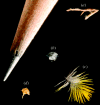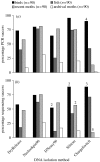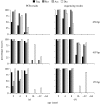Critical factors for assembling a high volume of DNA barcodes
- PMID: 16214753
- PMCID: PMC1609220
- DOI: 10.1098/rstb.2005.1727
Critical factors for assembling a high volume of DNA barcodes
Abstract
Large-scale DNA barcoding projects are now moving toward activation while the creation of a comprehensive barcode library for eukaryotes will ultimately require the acquisition of some 100 million barcodes. To satisfy this need, analytical facilities must adopt protocols that can support the rapid, cost-effective assembly of barcodes. In this paper we discuss the prospects for establishing high volume DNA barcoding facilities by evaluating key steps in the analytical chain from specimens to barcodes. Alliances with members of the taxonomic community represent the most effective strategy for provisioning the analytical chain with specimens. The optimal protocols for DNA extraction and subsequent PCR amplification of the barcode region depend strongly on their condition, but production targets of 100K barcode records per year are now feasible for facilities working with compliant specimens. The analysis of museum collections is currently challenging, but PCR cocktails that combine polymerases with repair enzyme(s) promise future success. Barcode analysis is already a cost-effective option for species identification in some situations and this will increasingly be the case as reference libraries are assembled and analytical protocols are simplified.
Figures




References
-
- Altschul S.F, Gish W, Miller W, Myers E.W, Lipman D.J. Basic local alignment search tool. J. Mol. Biol. 1990;215:403–410. 10.1006/jmbi.1990.9999 - DOI - PubMed
-
- Barrett R, Hebert P.D.N. Identifying spiders through DNA barcodes. Can. J. Zool. 2005;83:481–491.
-
- Bensasson D, Zhang D, Hartl D.L, Hewitt G.M. Mitochondrial pseudogenes: evolution's misplaced witnesses. Trends Ecol. Evol. 2001;16:314–321. 10.1016/S0169-5347(01)02151-6 - DOI - PubMed
Publication types
MeSH terms
Substances
LinkOut - more resources
Full Text Sources
Other Literature Sources

